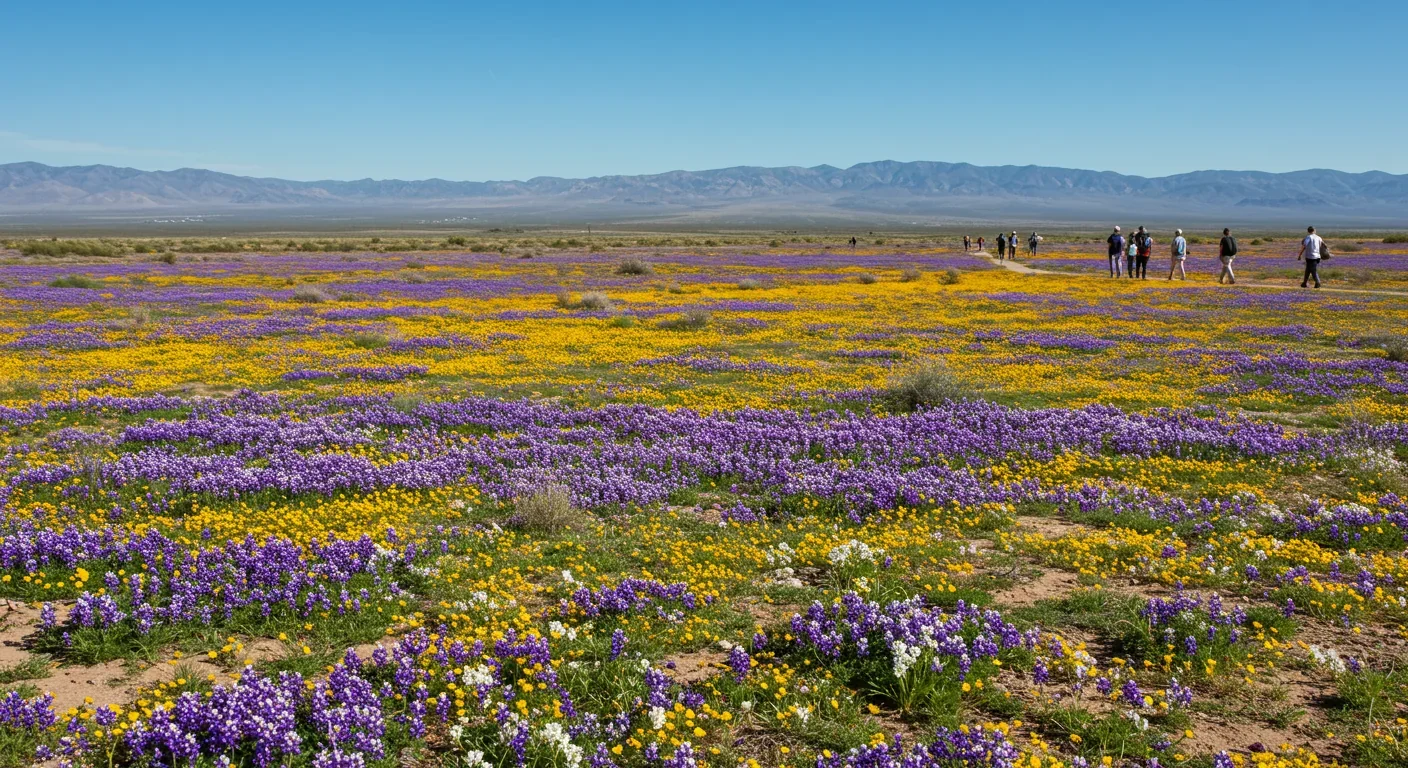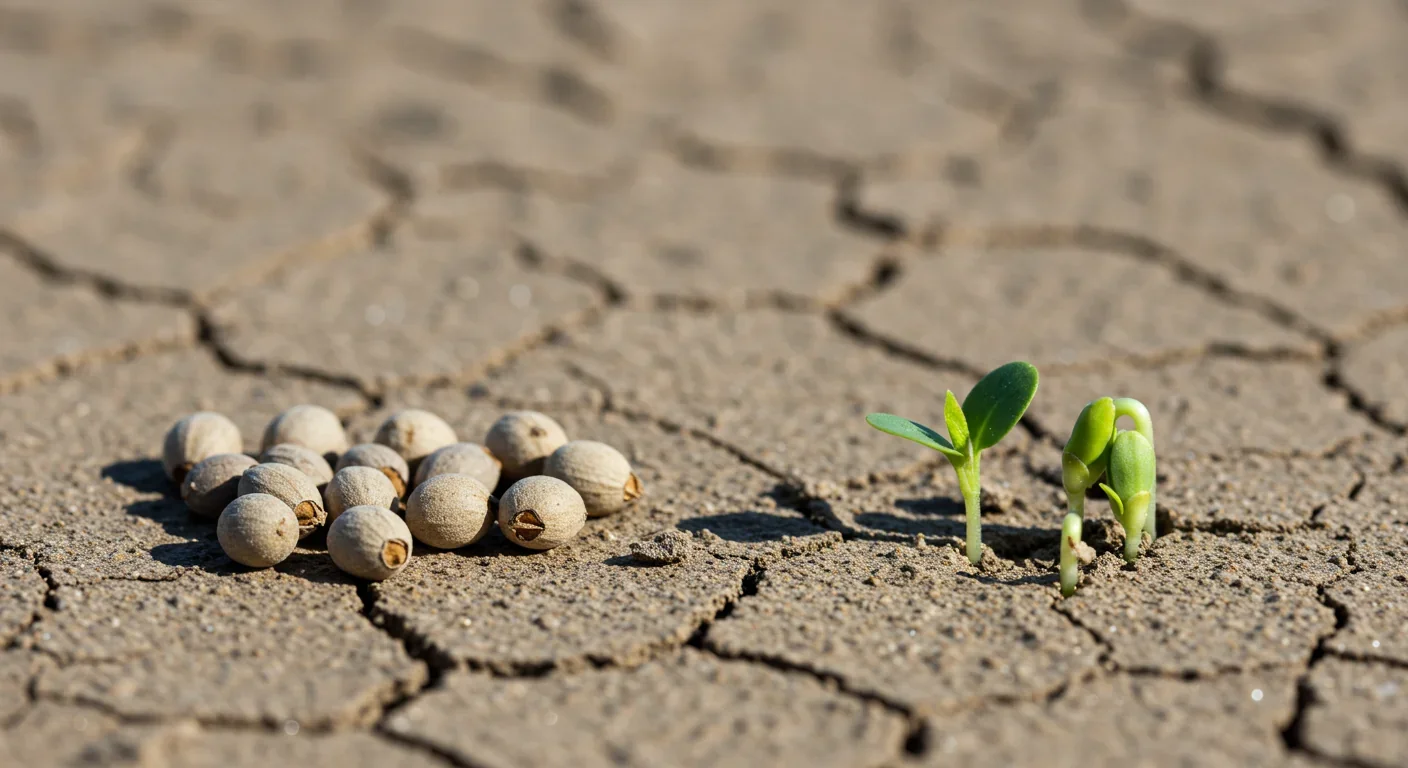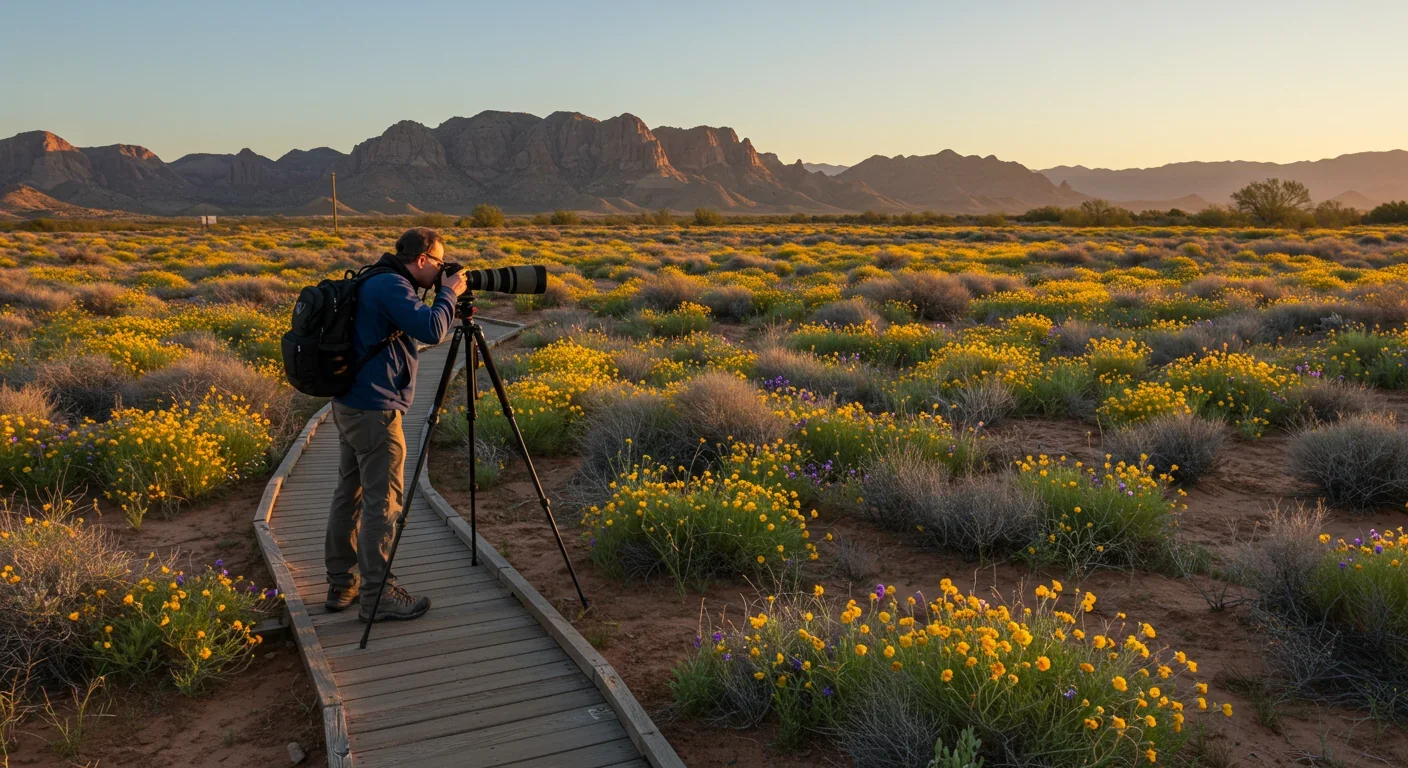Bombardier Beetle Chemical Defense: Nature's Micro Engine

TL;DR: Desert blooms transform barren landscapes into carpets of wildflowers when rare rainfall triggers seeds that can lie dormant for decades. Climate change is making these spectacular events both more intense and less predictable, threatening delicate ecosystems adapted to specific moisture patterns.

Imagine standing in the world's driest place, surrounded by nothing but rust-red rocks and cracked earth. Now imagine that same landscape transformed within days into a carpet of wildflowers so vivid it looks like someone spilled paint across the horizon. This isn't fantasy—it's what happens when rare rain hits a desert, and it's one of nature's most spectacular magic tricks.
Desert blooms are exploding back into our collective consciousness, and for good reason. These events aren't just pretty—they're windows into how life persists against impossible odds, how climate change is rewriting ecological calendars, and how entire ecosystems can lie dormant for years before erupting in a frenzy of color and life within hours of rainfall.
Here's what makes desert blooms extraordinary: the seeds that produce them can wait. And wait. And wait some more.
Desert annual seeds possess remarkable dormancy mechanisms that allow them to survive decades buried in sand, enduring temperatures that would cook most living things. These seeds don't just survive—they're engineered to respond only to very specific triggers. A light drizzle won't do it. The soil needs sustained moisture, the right temperature window, and in some cases, particular chemical signals before a seed decides it's safe to germinate.
Think of it as nature's most conservative investment strategy. A seed that germinates too early, based on a brief shower, will die. Natural selection has honed these dormancy mechanisms over millennia, creating plants that only bet their lives when conditions strongly suggest they'll actually complete their life cycle.
But here's where it gets wild: some desert seeds have what scientists call "epicotyl dormancy," which means even after the root emerges, the shoot waits. The plant literally hedges its bets by putting down a root first, then pausing before sending up leaves that could get scorched. This two-stage germination is like checking twice before crossing a deadly street.
So what actually triggers a bloom? It's not just about water hitting dirt.
In September 2024, warm ocean waters off Western Australia helped fuel what meteorologists call an "unseasonal drenching" that traveled nearly 2,000 kilometers across the continent. The ocean, acting as a massive heat battery, pumped moisture into the atmosphere. That moisture eventually fell on central Australia's red deserts, and within days, dormant seeds began their frantic race to reproduce.
Professor Matt England from the University of New South Wales explains the physics: "For every degree Celsius of warming, we get an extra 7 percent of moisture in the atmosphere." This isn't trivial math—it means our warming oceans are fundamentally changing rainfall patterns in deserts worldwide.
Chile's Atacama Desert, the driest desert on Earth, experienced exactly this phenomenon recently. Winter rains triggered a spring bloom featuring up to 200 documented native species. Jorge Carabantes, regional head of protected areas at Chile's National Forestry Commission, notes: "When we have winter rainfall, we get this flowering of different native species in the spring." The bloom duration? Brief. "They bloom for a short time before going dormant and then everything goes back to how it was before the rain."
The timing matters enormously. Too early in the season, and late frosts kill seedlings. Too late, and there isn't enough time to set seed before the heat returns. Desert plants have evolved to read a complex suite of signals—soil moisture persistence, day length, temperature patterns—before committing to growth.
While we're captivated by fields of flowers, something equally remarkable happens below the surface: the bloom isn't just plants.
Biological soil crusts—living communities of bacteria, fungi, lichens, and mosses—respond to the same moisture triggers. These crusts are desert superheroes: they prevent erosion, fix nitrogen, and retain water. When rain arrives, they explode with metabolic activity, transforming barren dirt into a living matrix that supports the flowering plants we notice.
And then there are the animals. Mass emergences of winged ants have been documented in the Mojave Desert following a single rain event after a year of drought. These synchronized emergences suggest that insects, like plants, possess internal clocks calibrated to precipitation pulses.
The entire ecosystem is playing a game of synchronized roulette, where everyone waits for the croupier—rain—to signal that it's time to bet everything.

California's desert superblooms have become celebrity events. Anza-Borrego Desert State Park, Death Valley, and the Mojave regularly feature in wildflower forecast reports that read like stock market predictions.
What makes a superbloom? Three factors generally align: a wet winter (ideally following a dry year that reduces competition from invasive grasses), mild temperatures during germination, and well-timed spring warmth. When these line up, deserts can host what locals call "carpet blooms"—flowers so dense you literally can't see the ground.
But here's the uncomfortable truth: these events are becoming both more common and more unpredictable. Climate change is intensifying rainfall events while also lengthening droughts between them. For desert ecosystems adapted to subtle variations in precipitation, this is like replacing a reliable metronome with random drum solos.
Western Australia hosts some of the planet's most extraordinary blooms, particularly in the Mid West region around Mullewa. The area is famous for wreath flowers (Lechenaultia macrantha), which grow only in disturbed clear spaces like road verges and gravel pits.
These plants haven't been successfully propagated in cultivation, making their wild displays genuinely irreplaceable. Natalie Hillier, manager of Mullewa's visitor centre, tracks the blooms like a meteorologist: "A couple of hot days will see them pop into vivid hues of pink." The timing window is measured in days, not weeks.
What's fascinating about Australia's blooms is their dependence on distant ocean conditions. Those 2,000-kilometer atmospheric rivers that carry moisture from warm seas to parched interiors? They're becoming more frequent as ocean temperatures rise. Australia's seas recorded their highest temperatures in 125 years of record-keeping, and that heat is being converted into atmospheric moisture that eventually falls on deserts.
The Namaqua region of South Africa, part of the Succulent Karoo biome, hosts what may be Earth's most biodiverse arid landscape. Namaqua National Park transforms each spring (August to September) into a riot of orange, purple, and white daisies.
Unlike the boom-bust annuals of California and Australia, Namaqua features more perennials and geophytes—plants with underground storage organs that can bloom repeatedly. This creates a more predictable, though no less spectacular, display. The Schaap River Canyon hikes during bloom season have become pilgrimage routes for botanists and photographers.
But even here, patterns are shifting. Local guides report blooms starting earlier, peaking faster, and ending more abruptly than in decades past. The reliability that made Namaqua a botanical calendar is fraying.
Here's where the science gets uncomfortable. Desert blooms are becoming simultaneously more spectacular and more fragile.
Warmer oceans mean more atmospheric moisture, which translates to more intense rainfall when it does occur. This can trigger larger blooms. But warming also means longer, hotter dry periods between rain events. Many desert annuals operate on tight margins—they need X days to germinate, Y days to flower, and Z days to set seed before heat returns. Compress that timeline, and you get reproductive failure.
There's also a mismatch problem emerging. Pollinators and plants evolved together, timing their life cycles to coincide. If rainfall patterns shift, plants might bloom before pollinators emerge, or vice versa. These phenological mismatches can cascade through entire food webs.
Dr. Simon Grainger from Australia's Bureau of Meteorology explains the mechanism: "The warm waters would have acted as a provider of a lot of moisture and energy for that system." But he's describing a climate system that's fundamentally changing. Historical patterns are becoming less reliable predictors of future events.
Desert blooms attract crowds. Lots of crowds. And that's both wonderful and terrible.
When Anza-Borrego experienced a superbloom in 2017, visitors overwhelmed the region. People trampled fragile biological soil crusts, drove off-road to get closer to flowers, and generally loved the desert to death. Park officials had to implement crowd control measures that felt more appropriate for Disneyland than a wilderness area.
The economic boost is real—local businesses thrive during bloom season—but so is the ecological cost. Those biological soil crusts that take decades to develop? A single footstep can destroy them. Seeds that survived years in the soil bank can be crushed in moments.
In Chile's Llanos de Challe National Park, tourists flocked to the recent bloom. One visitor captured the tension perfectly: "It's beautiful, something we must protect." But how do you protect something that becomes threatened by the very appreciation it generates?

If you're determined to see a desert bloom (and you should—they're transcendent), here's how to do it right:
Stay on established roads and trails. That empty stretch of desert that looks perfect for a detour? It's not empty. It's teeming with life you can't see—biological soil crusts, insect larvae, seed banks that took years to accumulate.
Time it right. Use official wildflower hotlines and apps. In California, LAist maintains superbloom forecasts. In South Africa, Namaqua National Park posts daily updates. Don't show up on rumors.
Go early or late. Peak bloom weekends bring crowds. Visiting on weekdays or during shoulder periods (early or late in the bloom window) reduces your impact and improves your experience.
Photograph ethically. Use a zoom lens instead of walking into flower fields. Never pick flowers—you're not just taking a pretty souvenir, you're stealing the next generation's seed bank.
Understand that you're seeing an emergency. These plants aren't blooming for your Instagram. They're in a reproductive sprint against death. The flower you're admiring has maybe two weeks to attract pollinators, get fertilized, and set seed before the heat returns.
Desert blooms are early warning systems for planetary change. These ecosystems operate at the margins of life, where small shifts in temperature or precipitation have outsized effects.
When blooms become more erratic, that's not just about flowers. It's a signal that moisture delivery systems are changing. When blooms happen earlier, it means temperature patterns are shifting. When they fail entirely, as they did in parts of the American Southwest in recent drought years, it means we've crossed a threshold.
Scientists increasingly use desert blooms as climate indicators. The timing and intensity of blooms provide data about rainfall patterns, temperature windows, and ecosystem resilience that complement traditional climate monitoring.
The irony is that while individual blooms may become more spectacular (thanks to increased moisture from warmer oceans), their long-term reliability is declining. We might get bigger shows, but less often, and less predictably.
Here's what keeps desert ecologists up at night: seed bank depletion.
Desert seed banks are finite resources. Each bloom draws down the bank. If blooms become more frequent but conditions don't allow seed production (because it's too hot, or pollinators are mistimed), the bank depletes without being replenished. After several failed reproductive cycles, there are no more seeds left to germinate.
This isn't theoretical. Some desert regions have documented declining bloom intensity despite adequate rainfall, suggesting their seed banks are running low. Once depleted, it could take decades—or longer—to rebuild, assuming climate conditions stabilize enough to allow it.
Beyond visiting responsibly, there are practical ways to support desert bloom ecosystems:
Support conservation organizations working in arid regions. Groups like the Mojave Desert Land Trust, South African National Parks, and Australia's Bush Heritage work to protect critical habitat.
Advocate for climate action. Desert blooms are increasingly threatened by climate instability. The single biggest thing you can do for these ecosystems is support policies that reduce greenhouse gas emissions.
Learn the plants. When you understand what you're looking at—not just "pretty flowers" but Caulanthus inflatus or Dimorphotheca sinuata—you develop a relationship with these landscapes that goes beyond aesthetics.
Share thoughtfully. If you post bloom photos on social media, consider not geotagging exact locations of sensitive areas. You want to inspire wonder, not stampedes.
Standing in a desert bloom is one of those experiences that recalibrates your sense of what's possible. That life can persist for years as dormant seeds, then explode into a reproductive frenzy in a matter of days, seems almost miraculous.
But it's not a miracle—it's evolution, physics, and chemistry operating at the edge of survival. These ecosystems are teaching us about resilience, timing, and the delicate calibration between opportunity and catastrophe.
As our climate continues changing, desert blooms will increasingly serve as both spectacular shows and sobering reminders. They'll bloom in places and times we don't expect. They'll fail when we hope for them. They'll teach us, whether we're paying attention or not, that life in extreme environments operates on razor-thin margins.
The question isn't whether deserts will continue blooming—some will, some won't. The question is whether we'll learn from these ephemeral explosions of life before we push too many ecosystems past their tipping points.
Next time you see photos of a desert carpeted in flowers, remember: you're looking at a sophisticated survival strategy millions of years in the making, triggered by a specific constellation of rainfall, temperature, and timing. You're seeing an ecosystem gambling everything on a brief window of opportunity.
And you're seeing, perhaps, a glimpse of how life will persist—or struggle to persist—as our planet continues warming. The blooms will tell us where we're headed, if we're wise enough to read their signals.

Recent breakthroughs in fusion technology—including 351,000-gauss magnetic fields, AI-driven plasma diagnostics, and net energy gain at the National Ignition Facility—are transforming fusion propulsion from science fiction to engineering frontier. Scientists now have a realistic pathway to accelerate spacecraft to 10% of light speed, enabling a 43-year journey to Alpha Centauri. While challenges remain in miniaturization, neutron management, and sustained operation, the physics barriers have ...

Epigenetic clocks measure DNA methylation patterns to calculate biological age, which predicts disease risk up to 30 years before symptoms appear. Landmark studies show that accelerated epigenetic aging forecasts cardiovascular disease, diabetes, and neurodegeneration with remarkable accuracy. Lifestyle interventions—Mediterranean diet, structured exercise, quality sleep, stress management—can measurably reverse biological aging, reducing epigenetic age by 1-2 years within months. Commercial ...

Data centers consumed 415 terawatt-hours of electricity in 2024 and will nearly double that by 2030, driven by AI's insatiable energy appetite. Despite tech giants' renewable pledges, actual emissions are up to 662% higher than reported due to accounting loopholes. A digital pollution tax—similar to Europe's carbon border tariff—could finally force the industry to invest in efficiency technologies like liquid cooling, waste heat recovery, and time-matched renewable power, transforming volunta...

Humans are hardwired to see invisible agents—gods, ghosts, conspiracies—thanks to the Hyperactive Agency Detection Device (HADD), an evolutionary survival mechanism that favored false alarms over fatal misses. This cognitive bias, rooted in brain regions like the temporoparietal junction and medial prefrontal cortex, generates religious beliefs, animistic worldviews, and conspiracy theories across all cultures. Understanding HADD doesn't eliminate belief, but it helps us recognize when our pa...

The bombardier beetle has perfected a chemical defense system that human engineers are still trying to replicate: a two-chamber micro-combustion engine that mixes hydroquinone and hydrogen peroxide to create explosive 100°C sprays at up to 500 pulses per second, aimed with 270-degree precision. This tiny insect's biochemical marvel is inspiring revolutionary technologies in aerospace propulsion, pharmaceutical delivery, and fire suppression. By 2030, beetle-inspired systems could position sat...

The U.S. faces a catastrophic care worker shortage driven by poverty-level wages, overwhelming burnout, and systemic undervaluation. With 99% of nursing homes hiring and 9.7 million openings projected by 2034, the crisis threatens patient safety, family stability, and economic productivity. Evidence-based solutions—wage reforms, streamlined training, technology integration, and policy enforcement—exist and work, but require sustained political will and cultural recognition that caregiving is ...

Every major AI model was trained on copyrighted text scraped without permission, triggering billion-dollar lawsuits and forcing a reckoning between innovation and creator rights. The future depends on finding balance between transformative AI development and fair compensation for the people whose work fuels it.